The article will tell you about what happens in the body after a surgical procedure, why it is necessary to apply sutures and how soon they need to be removed.
Contents of
- What day are the sutures removed and whether the Caesarean section, labor, episiotomy of the perineum, after the operation, is painful on the cervix?
- What day are the sutures removed and if the appendicitis, hernia, laparoscopy is painful after the operation?
- On what day are the sutures removed and is it painful on the gum after removal, implantation of the tooth?
- On what day are the seams removed and is it painful from a wound on the arm, leg, face?
- On what day are the sutures removed and if it's painful after rhinoplasty, blepharoplasty?
- Video: "Removal of surgical sutures"
What day are the sutures removed and whether after a Caesarean section, delivery, episiotomy of perineum, on the cervix is painful?
Any surgical intervention leaves a trace behind - a cut, sewn with special threads or stapled together. The speed and ease of healing of any scar depends on how difficult and deep the problem was.
The most common operation in the world is the "Caesarean section," which in most cases is simply a necessity( the complex position of the baby in the womb, the cord with the umbilical cord, the narrow pelvic bones of the mother).This intervention is characterized by a strip incision in the lower abdomen( horizontal, or vertical).
The seam on the incision after caesarean section is superimposed in the maternity ward. The surgeon sutures under general anesthesia, and during the entire stay in the hospital, the nurse always treats the seam with antiseptic means, changing the bandage.
If the seam is applied with ketgut threads, it is not necessary to remove it, since the thread dissolves over time( it is made of natural material and absorbed from 60 to 80 days completely without residue).If the seam is applied with silk threads and staples, their can be removed after 5 or 7 days of , depending on the complexity of the healing course.
After cesarean a scar is formed, which begins to form around the 7th day. Do not water the seam for the first week, and therefore you can take a shower only after 7 days. It is worth knowing that this intervention is very painfully experienced, because as a result of the operation all layers of the abdominal wall are broken.
In the case of natural childbirth, the situation is slightly simpler. However, it should be noted that in every woman birth can occur in different ways: difficult or easy. Everything depends on the physiological structure of the woman, her experience, the number of births on the account, the state of health, the ability to push and the correct behavior of the medical team during childbirth.
Episiotomy of is a cut that is made to a woman in the perineal region( in the vagina) in order to facilitate the process of childbirth. As a rule, this incision is made after the introduction of a local anesthetic, in case the birth is "fast" for this there is no time.
Sutures after delivery are usually removed on day 4-5 of , if the tissues heal well and there are no complications. In some cases, the process can take up to 7-10 days maximum .In the case when a woman can not be born, relax, or with accelerated or induced births, the cervix of the uterus does not open, the process of its rupture is irreversible. Then the seams are superimposed on it as well, their healing lasts up to 7-10 days.
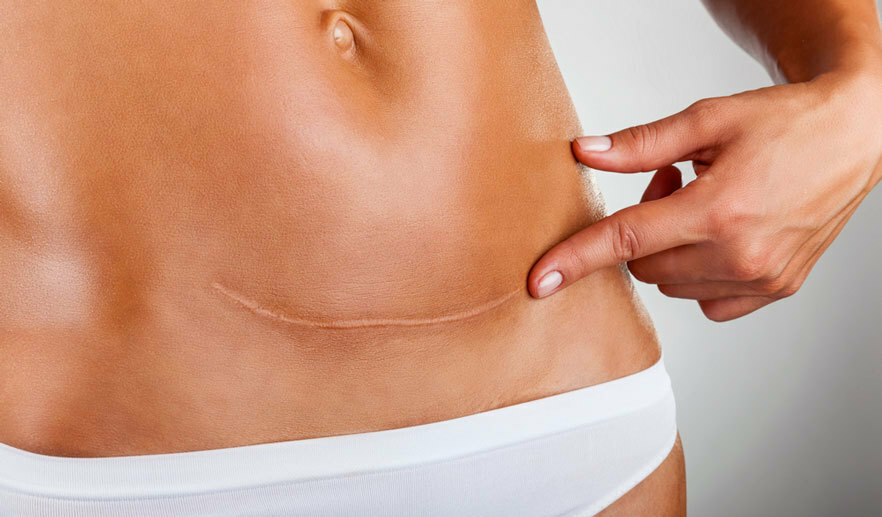 Suture removal after caesarean section and natural childbirth
Suture removal after caesarean section and natural childbirth What day are the sutures removed and if the appendicitis, hernia, laparoscopy is painful after the operation?
This disease, like appendicitis, occurs quite often in all layers of the population: children, adults, men and women. The disease is treated only with the help of surgical intervention. In its essence, appendicitis is an inflammatory process that occurs in the "cecum", or rather, in its process, the function and purpose of which has not yet been studied by medicine to the end.
Anything can provoke the inflammatory process:
- Mechanical injury
- Infection in the body
- Blood circulation in the body
- Disorders of the endocrine system
- Dysfunction of the digestive tract
IMPORTANT: Statistics prove that women are more likely to suffer from inflammation of appendicitis than men. The disease becomes more common between the ages of 20 and 40 years.
Emergency appendicitis cutting will help to completely eliminate the problem. As a rule, intervention does not bear serious consequences and dangers. If you cut out appendicitis immediately after exacerbation, recovery and improvement of the patient's condition will follow the next day.
The incision to remove the apendix is made in the lower abdomen on the right. After the excision of the skin remains a scar that requires proper care. The length of the scar, on average, is 3-4 cm. To make the cut look neat and easy to heal, the doctor requires responsibility, professionalism, experience.
If after the operation there were no complications( fever, infection, getting microbes into the wound) and the scar heals well, remove the seams allowed to the doctor after 10-14 days .If the doctor imposes sutures from catgut filaments, then their resorption occurs within 2-3 weeks for . For a period of 10-14 days the tissues will be restored. But it is important to know that even after the removal of stitches, the patient is required to be on a sparing and inactive mode for about 6 weeks.
Another surgical intervention that can be performed in the abdomen is the "cutting" of the hernia."Hernia" is a disease manifested by the protrusion of internal organs( intestines) from the cavity in which they were intended to be. It can happen for several reasons, but treatment always involves an operation that results in plastic. Too much protrusion is reduced surgically.
In case of "light" operation and stitching from silk threads or staples, their removal takes place in a week. The very procedure for removing the joints occurs quickly enough for several minutes. It is worth noting that this is quite unpleasant. Bandage, which is customary to wear after surgery and during the rehabilitation period should not be removed after the removal of stitches, it rushes until the muscle tone of the body in the area of operation is acquired. In addition, the bandage will hold the scar itself, so that he can not disperse after the removal of stitches.
Laparoscopy is the minimal surgical intervention that is necessary in order to fix health problems and bring the body minimal damage. Laparoscopy is performed by inserting special spokes( surgical instruments).However, this intervention also requires stitches for the early healing of
. As a rule, scars remain small enough. Apply a seam after laparoskopii can ketgutovymi or silk threads. The latter can be shot in a week. But, everything depends only on the individual characteristics of the person and the course of his illness. Precisely to say about how soon the seam can be removed, the surgeon can tell only.
IMPORTANT: Any scar produced as a result of surgical intervention, bandage or as a result of laparoscopy, requires appropriate care: treatment with antiseptic, compliance with the body's calm, diet and careful observation by the attending physician, nurse.
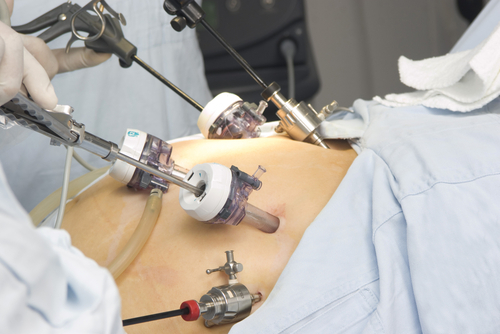 Laparoscopy: operation
Laparoscopy: operation What day are the sutures removed and is it painful on the gum after removal, implantation of the tooth?
The tooth can be removed only if it is destroyed, it contains inflammatory and putrefactive processes, it hurts because of a sore nerve, poses a threat to neighboring teeth. To pull out a tooth can only a dentist with a surgical license. Tearing teeth can occur, both in public and private clinics.
It's worth noting that most people pull out "wise" teeth due to the fact that they bring them discomfort and pain. Tearing of the upper teeth occurs slightly easier than the lower ones, but, nevertheless, such intervention requires a number of important measures.
The tooth is pulled out under anesthesia. In the process of extracting a tooth a person can feel only pressure, pulling sensations and crackling( if the doctor breaks the "complex" tooth into two parts to pull out).Pain sensations after tooth extraction come only when the analgesic effect ends. But, a good and attentive doctor, always appoints his patient the use of additional drugs that improve health and dull pain.
In case of pulling out lower teeth( and especially wise ones), there is a possibility of frequent entry of bacteria into the wound, and therefore( to avoid infection) the doctor puts seams. So the gum more quickly heals and fuses, it does not bleed much and does not give a person any discomfort.
After removing the tooth doctor should clean the wound of excess gums torn pieces to check for the presence of residual fragments of the tooth, bleeding blunt swab and carefully sew. After 2-3 days the patient comes to the doctor in order to exclude the presence of an inflammatory process. You can remove stitches for 6-7 days. By this time the gum heals and fuses.
Remove these seams almost painlessly. The patient only feels the moment of cutting the thread and feeling the elongated thread( line) out of the gum. This does not hurt because the thread itself is very thin, and the gum is not the most sensitive part of the body.
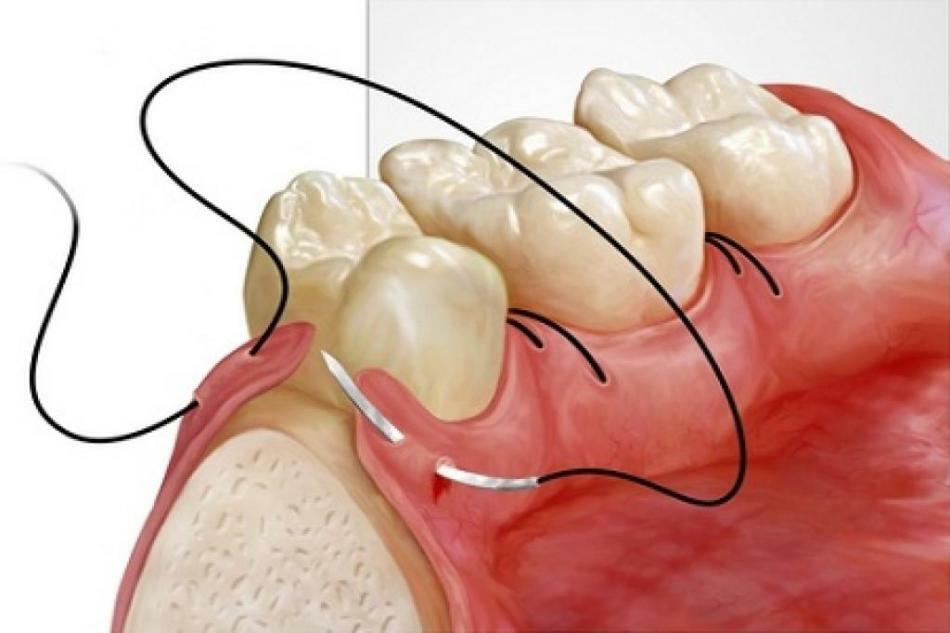 Suturing the gums
Suturing the gums On what day are the sutures removed and is it painful from a wound on the arm, leg, face?
The removal of any surgical sutures depends only on how difficult the surgical procedure was and how hard the patient suffered the entire operation. The painfulness of the site of intervention depends on how deep the incision was, and what kind of operation was performed.
Why seal the seams? This is a necessity. Operation - stress for the body and body. The surgeon helps to survive this stress, cope with the consequences of the intervention and help to recover as soon as possible. Sutures in place of the incision are superimposed so that the wound does not get an infection, does not lead to inflammation, bacteria, protect from blood loss and death.
Healing of any incision on the arm, leg, face and other parts of the body usually occurs within the first 7-10 days. This is the time required for tissues to develop special "collagen" cells, which increase connective tissue. It is worth noting that these time norms are very conventional because the younger the person, the healing process is faster. In the "old" organism, the process of regeneration( the production of new cells) is much slower than in young people and children.
IMPORTANT: The removal of seams is quite simple. A doctor or a nurse, using medical scissors and tweezers, first cut the stretched threads, and then pull them by the tips. The process is unpleasant, but completely tolerable.
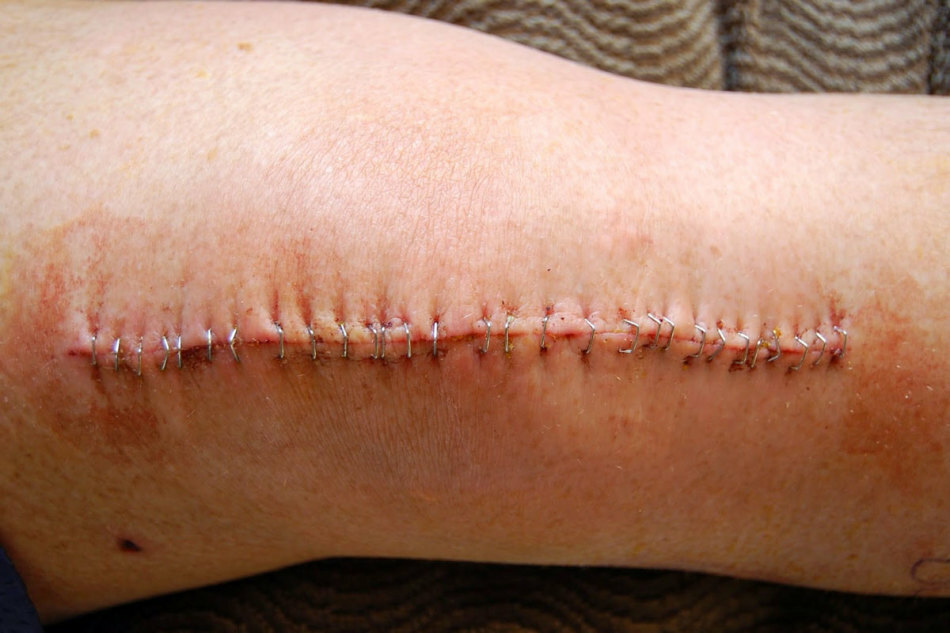 Sealing the seams on the body
Sealing the seams on the body What day are the seams removed and if the pain after rhinoplasty, blepharoplasty?
Blepharoplasty is a surgical intervention that is necessary in order to remove the impending eyelid by cutting out "excess" tissue. As a rule, the seams in this operation are superimposed with special catgut threads, which have the property of being absorbed and taken up by the body. This is done in order not to disturb the delicate skin again, not to provoke its puffiness and to give painful sensations( after all the face is sensitive to the slightest touch).
When carrying out blepharoplasty, the incisions and seams are superimposed as close as possible to the line where the eyelashes grow. This gives the advantage of being seams minimally conspicuous. Large scars are removed by a number of cosmetic procedures, which are prescribed by the doctor. Touch the seams and handle them yourself in no case it is impossible. This should be done only by medical personnel. Sutures are removed always different, depending on the individual characteristics of each organism, and age, as a rule, at least - is 3 weeks and a maximum - 6.
Blepharoplasty Rhinoplasty - surgical intervention for correcting the shape of the nose. After surgery, the doctor puts a special gauze bandage impregnated with an antibiotic, as well as "splints" - hard plaster cast, which in any case can not be disturbed during wound healing.
Each operation of rhinoplasty takes place differently and all depends on the scale of the surgical intervention. As a rule, after 2-4 days the doctor can remove tampons and bandages soaked in antiseptic means and after 4-5 after the operation it is already possible to remove the stitches, if everything goes well and the healing did not wait. The sutures from the sutures dissolve independently after about 2-3 weeks. You can remove gypsum 10-14 days after the operation.
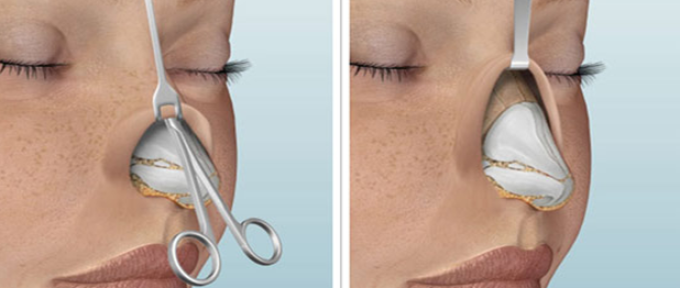 Rhinoplasty
Rhinoplasty 